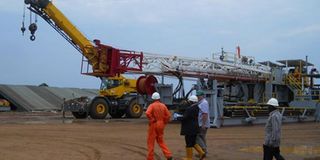Government denies abandoning Kenya’s pipeline route

Oil workers at Kigogole-5 Oil Well in Buliisa District. Uganda is looking at maximising returns from the cheapest pipeline option. FILE PHOTO
Kampala. Uganda’s Energy minister Irene Muloni was in Kenya for the best part of last week to meet Kenyan government officials regarding the route of the pipeline.
The Kenya visit comes a few days after Uganda, Tanzania government and Total E&P signed a Memorandum of Understanding (MoU) to explore the possibility of the pipeline passing through Tanzania from Hoima.
Kenya and Uganda had started working on modalities of financing a 1,500km route from Hoima through Lokichar in Northern Kenya to the Lamu Port.
The signing of the MoU with Tanzania appeared contrary to the understanding with the Kenyan government over two possible routes in the country at the recently concluded Northern Corridor Summit and bilateral discussions between President Museveni and Uhuru Kenyatta.
Dangling the carrot
Discussions and feasibility study conducted by Toyota Tusho, a consultant, had only explored the routes through Kenya. The view to explore the Tanzania options has cast doubt on the Kenyan option, leading Mr Muloni to skip the Ministry of Energy Joint Sector Review workshop that took place on Thursday and Friday last week in order to purge any concerns by the Kenyan government.
Mr Fred Kabagambe-Kaliisa, the permanent secretary in the Ministry of Energy confirmed Ms Muloni had indeed gone to Nairobi to meet Kenyan government officials, among them Mr Henry Rotich, the acting cabinet secretary for Energy and Petroleum.
On the sidelines of the Joint Sector Review for the Ministry of Energy, Mr Kaliisa also emphasised that Kenya had not been abandoned but rather they were looking at the “least cost possible” route for the oil pipeline.
“The MoU with Kenya is not hanging in the balance,” he said, insisting that a cheaper route would generate more returns for the government.
In a statement released early last week after signing the MoU with Tanzania and Total E&P, Mr Kaliisa said: “As a country, we are evaluating the routes with the idea that we have the least cost route because we would like to ensure that our crude oil has value.” Key to the route of the pipeline is the cost.
According to Mr Kaliisa, a higher cost of transportation would mean less value and returns for the country.
When the Northern Corridor summit was held, the agreement for the pipeline route through Kenya worked on four assumptions, among them security on the route and affordability. That explains why there were two proposed routes through Kenya so that the “least cost” is picked from these.
Proactive Kenya
In the National Development Plan II (2015 – 2020), in some of the infrastructure developments being proposed, the only pipeline mentioned is through Kenya.
However, ministry of Energy officials always had the route through Tanzania to Tanga on their books. The trouble, according to sources within the ministry, was that Kenya had been more proactive in engaging the Uganda government.
The oil companies, specifically Tullow were upbeat about the Kenyan route.
In fact, in July 2015, Mr Paul McDade, the chief executive officer Tullow Oil, told investors “there is really no work on analysis to be done; all that it requires is a decision.” This he said in regards to the two proposed routes in Kenya.
Ms Alice Alaso Asianut, the Woman MP for Serere District and a member of the Natural Resource committee in Parliament, said: “As a committee, when Uganda decides to be part of a pipeline, it is our sincere hope that it will be a very cost effective undertaking, which will give this country maximum dividends.”
She added: “ But we also know from a procurement perspective, Uganda has a weak adherence to the rules in the region. I can only hope that when the committee resumes, the chairperson shall consider calling the minister to give an explanation on the progress of the pipeline.”
Tanzania better option
Mr Enock Nyorekwa Twinoburyo, an economist and PhD Research Fellow at the University of South Africa, looks at Tanzania as the better option.
“The Tanzania line breaks off the coalition for the willing walls and serves the broader interests of regional integration. Secondly, for Uganda our infrastructure dependence on Kenya is overly increasing and the Tanzania route can deleverage our options in case cross country conflict,” he said.
He added: “Thirdly, Northern Kenya route would be susceptible to security attacks and would require heavy security investments. Remember the Tanzania line adds Tanzania on the potential of enjoying the refinery.”
Total’s security concerns over Kenya
Before the leaders of Kenya and Uganda zeroed on in a route, Total E&P raised the red flag. The Reuters news agency quotes the global chief executive of Total saying that the concern around the Kenya route is security.
“There are debates over security in Kenya which to me, are very important,” Mr Pouyanne is quoted in a Reuters story.
Several attacks in Kenya by mostly the al-Shabab have been orchestrated in Northern Kenya, which borders Somalia. The pipeline route through Kenya would go through this area. The risks around it would increase insurance costs and could cause investor apathy. Total is learning from the experience of vandalism on the pipeline infrastructure in Nigeria.
In fact, at the signing of the MoU between to explore the Tanzania route, Tullow and CNOOC were missing.
The background
In 2014, government and the oil companies signed agreement on how Uganda’s oil would be commercialised.
They agreed that government will be responsible for the refinery construction and the oil companies will bear the responsibility of the oil pipeline. The pipeline is projected to cost $4b (Shs14.5trillion).




